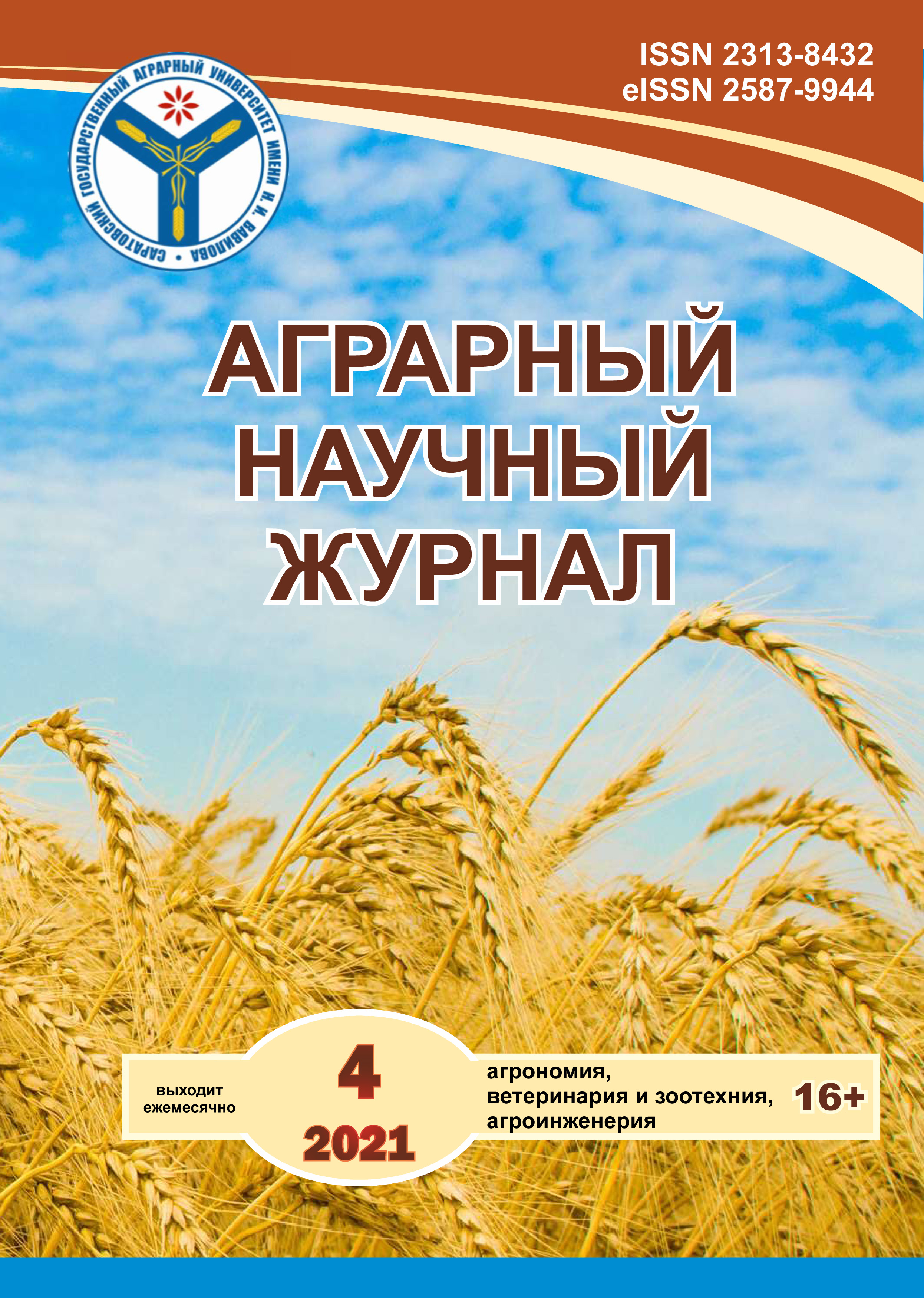Efficiency of use of microelements in cultivation of sweet pepper during irrigation in the subzone of light chestnut soils of the Volgograd region
DOI:
https://doi.org/10.28983/asj.y2021i4pp12-16Keywords:
sweet pepper, germination, germination energy, microelements, pre-sowing seed treatment;, foliar feeding of plants, productivity, product qualityAbstract
The results of studies of scientifically grounded use of microelements in sweet pepper crops, as an important factor in increasing the yield of vegetable crops and improving the quality of products, are presented. The purpose of our research was to substantiate the influence of the use of trace elements in the technology of sweet pepper cultivation on the growth and development of plants, the productivity and quality of the products of this culture. The experimental part of the work was carried out in 2014-2019 in the subzone of light chestnut soils of the Volgograd region. Experiments on the study of trace elements were carried out by pre-sowing seed treatment and foliar feeding of plants. Chemically pure compounds of manganese sulfate, zinc sulfate, copper sulfate, ammonium molybdate, boric acid were used as microelements. The use of trace elements in the dry-steppe zone of the Lower Volga region is an important agricultural technique that helps to accelerate growth, development, increase productivity and improve the quality of pepper fruits. It is recommended to carry out pre-sowing treatment of seeds with solutions of boric acid (0.29 g / 1 l of water), copper sulfate (0.20 g / 1 l of water) and manganese sulfate (0.16 g / 1 l of water) (the ratio of the weight of seeds to the solution 1: 2) as a way to increase seed vitality, speed up yield and improve seedling quality. In order to increase the yield and improve the quality during the budding period of peppers, it is necessary to carry out foliar dressing, first of all, with solutions of boric acid (0.29 g / 1 l of water), ammonium molybdenum (0.10 g / 1 l of water), water consumption 1 l / 10 m2. Due to its high efficiency, simplicity and availability, pre-sowing seed treatment and foliar feeding of plants with microelements will find wide application in vegetable growing.
Downloads
References
Ахмедов А.Д., Богомолов Д.Ю., Васильева В.И. Влияние регулируемых факторов на продуктивность и качество плодов сладкого перца при капельном орошении в условиях Волгоградского Заволжья // Известия Нижневолжского агроуниверситетского комплекса: наука и высшее профессиональное образование. – 2012. – № 4(28). – С. 16–20.
Байрамбеков Ш.Б., Киселева Н.Н. Технология получения раннего урожая перца сладкого в условиях орошения // Орошаемое земледелие. – 2016. – № 4. – С. 23–24.
Булыгин С.Ю. Микроэлементы в сельском хозяйстве. – Днепропетровск, 2007. – 102 с.
Доспехов Б.А. Методика полевого опыта (с основами статистической обработки результатов исследований). – 5-е изд. перераб. и доп. – М.: Агропромиздат, 1985. – 351 с.
Калмыкова Е.В., Петров Н.Ю. Комплексные водорастворимые удобрения в технологии возделывания овощных культур в условиях Нижнего Поволжья // Известия Оренбургского государственного аграрного университета. – № 2. – 2017.– С. 29–31.
Калмыкова Е.В., Петров Н.Ю., Нарушев В.Б., Мягкова Е.Г. Агротехнология возделывания перца сладкого в зоне светло-каштановых почв Прикаспия при орошении // Аграрный научный журнал. – 2017. – № 6. – С. 15–19.
Калмыкова Е.В., Петров Н.Ю., Калмыкова О.В. Адаптивная технология возделывания перца сладкого на светло-каштановых почвах Волгоградской области // Вестник Алтайского государственного аграрного университета. – 2017. – № 9(155). – С. 9–14.
Калмыкова Е.В., Петров Н.Ю., Калмыкова О.В. Повышение продуктивности перца сладкого при обработке регуляторами роста в условиях Волгоградской области // Известия Нижневолжского агроуниверситетского комплекса: наука и высшее профессиональное образование. – 2017. – № 3. – С. 56–64.
Литвинов С.С. Методика полевого опыта в овощеводстве. – М., 2011. – 648 с.
Меньщикова Я.В., Лушникова Т.А. Влияние внекорневой обработки растворами циркона и сульфата калия на рост и урожайность перцев и томатов // Вестник Курганского государственного университета. Серия: Естественные науки. – 2017. – № 4(47). – С. 37–41.
Ступаков С.Т. Методы оценки качества и химического состава плодов и овощей. – М., 2007. – 64 с.
Юдаев И.В., Азаров Е.В., Белицкая М.Н., Грибуст И.Р. Предпосевная обработка семян: опыт Нижнего Поволжья // Енергетика i автоматика. Науковий журнал. До 115-рiччя заснувания Нацiонального унiверситету бiоресурсiв i природо-користування Украiни. – 2013. – №3. – С. 48–54.
Barzegar T., Fateh M., Razavi F. Enhancement of postharvest sensory quality and antioxidant capacity of sweet pepper fruits by foliar applying calcium lactate and ascorbic acid // Scientia Horticulturae, 2018, No 241, Р. 293–303.
Belyaev A.I., Pleskachev Yu.N., Petrov N.Yu., Zvolisky V.P., Kalmykova Е.V., Fomin S.D., Pygacheva A.M., Kalmykova O.V. Microelements application methods influence on physiological-biochemical processes and yellow pepper yields // IOP Conference Series: Earth and Environmental Sciencе, 17–18 октября 2019 г. – Воронеж, 2020, Р. 012013.
Gajc-Wolska J., Mazur K., Niedzi?ska M., Kowalczyk K., Zo?nierczyk P. The influence of foliar fertilizers on the quality and yield of sweet pepper (Capsicum annuum L.) // Folia Horticulturae, 2018, No 30(2), Р. 183–190.
Zhang B., Li R., Yan J. Study on activation and improvement of crop seeds by the application of plasma treating seeds equipment // Archives of Biochemistry and Biophysics, 2018, No 655, P. 37–42.
Downloads
Published
Issue
Section
License
Copyright (c) 2021 The Agrarian Scientific Journal

This work is licensed under a Creative Commons Attribution-NonCommercial 4.0 International License.








